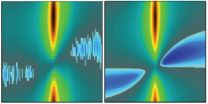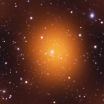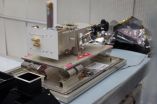(Press-News.org) A massive galaxy cluster nearly six billion light years from Earth has been discovered with an astounding and unexpected burst of star formation – more prodigious than any galaxy cluster yet observed, an international team of astronomers and NASA announced today.
In a wide-ranging discussion on the eve of the announcement, two of the leading astronomers on the project talked about the record-breaking galaxy cluster, called Phoenix, and how its surprising properties are prompting astronomers to re-think how galaxy clusters – among the largest structures in the universe – form and evolve over cosmic time.
"This discovery in the Phoenix Cluster suggests a whole new twist to … how massive galaxies at the center of galaxy clusters grow," said Hubble Fellow Michael McDonald, a researcher at the Kavli Institute for Astrophysics and Space Research at MIT and also the lead author of a paper appearing Aug. 16 in the journal Nature. "It allows for another mechanism for the growth of these galaxies. It opens up a whole new area of research."
Bradford Benson, a researcher at the Kavli Institute for Cosmological Physics at the University of Chicago and a co-author of the paper, noted that the massive Phoenix Cluster, which is named for the constellation that marks its direction on the sky, was discovered during a survey by the South Pole Telescope. "The Phoenix Cluster stood out as having very high X-ray emission from its center, so much that it made the entire cluster the most luminous X-ray cluster ever observed," Benson said. "That immediately peaked our interest, because it suggested that cool gas was condensing in the center of the cluster."
The prevailing view of astronomers who study clusters has been that their central galaxies are largely dormant, full of old stars and lacking the kind of vigorous star formation that marked their youth. But the central galaxy in Phoenix signaled new star formation.
The research team followed up the initial discovery of Phoenix with observations by numerous telescopes – compiling enough data to convincingly conclude that Phoenix was unlike any galaxy cluster ever seen.
"I am a very glass half-full guy," McDonald said. "I immediately thought that it was extremely exciting, and I needed people to reign me in." Still, McDonald noted that to go from the initial excitement of finding evidence for rapid star formation to actual confirmation "required several months of checking results and getting additional data."
McDonald and Benson shared why they think the central galaxy is so active with starbursts, and how they may have caught the galaxy cluster during a brief period that all clusters go through in their evolution – although to be sure about that, more data is needed. As for next steps, according to McDonald, "We're going to try to find more clusters, either like this or unlike this. The reason is that it's really hard to draw any conclusion based on one galaxy cluster. So while this is exciting, it doesn't necessarily tell us about the overall evolution of galaxies and galaxy clusters."
Benson said the exciting discovery promises to be a gift that keeps on giving. "Cosmology tries to answer some of the biggest questions about the universe, such as 'How old is it?' and 'How did it evolve?'" Benson noted that studying galaxy clusters helps astronomers better understand those mysteries, such as the nature of dark energy, the unknown force that's causing the universe to expand at accelerating rates. "We want to understand (galaxy clusters) better so we can use them as cosmological tools," he said. "But they are also interesting by themselves."
The complete discussion can be found at: http://www.kavlifoundation.org/science-spotlights/phoenix-cluster-mcdonald-benson
INFORMATION: END
A long-time staple of science fiction is the tractor beam, a technology in which light is used to move massive objects – recall the tractor beam in the movie Star Wars that captured the Millennium Falcon and pulled it into the Death Star. While tractor beams of this sort remain science fiction, beams of light today are being used to mechanically manipulate atoms or tiny glass beads, with rapid progress being made to control increasingly larger objects. Those who see major roles for optomechanical systems in a host of future technologies will take heart in the latest results ...
JUPITER, FL, August 15, 2012 – Working with a national team of researchers, a scientist from the Florida campus of The Scripps Research Institute has shown for the first time a link between low levels of a specific hormone and increased risk of metabolic disease in humans.
The study, published online ahead of print in The Journal of Clinical Endocrinology & Metabolism, focuses on the hormone adropin, which was previously identified by Scripps Research Associate Professor Andrew Butler's laboratory during an investigation of obese and insulin-resistant mice. Adropin is ...
Astronomers have found an extraordinary galaxy cluster — one of the largest objects in the universe — that is breaking several important cosmic records. The discovery of this cluster, known as the Phoenix Cluster, made with the National Science Foundation's South Pole Telescope, may force astronomers to rethink how these colossal structures, and the galaxies that inhabit them, evolve.
Follow-up observations made in ultraviolet, optical and infrared wavelengths show that stars are forming in this object at the highest rate ever seen in the middle of a galaxy cluster. The ...
CORAL GABLES, FL (August, 15, 2012)--University of Miami scientists have developed a way to switch fluorescent molecules on and off within aqueous environments, by strategically trapping the molecules inside water-soluble particles and controlling them with ultraviolet light. The new system can be used to develop better fluorescent probes for biomedical research.
Previous studies have used water-soluble particles to bring organic molecules into water. What is novel about this system is the use of a photoswitching mechanism in combination with these particles.
The findings ...
A National Science Foundation-funded radio telescope in Antarctica has found an extraordinary galaxy cluster that may force astronomers to rethink how galaxy clusters and the galaxies that inhabit them evolve.
The galaxy cluster was discovered some 5.7 billion light years from Earth by the 10-meter wide South Pole Telescope (SPT) located at NSF's Amundsen-Scott South Pole Station in Antarctica, which is funded by NSF's Office of Polar Programs.
NSF manages the U.S. Antarctic Program, through which it coordinates all U.S research and required logistical support on the ...
Scientists using the Lyman Alpha Mapping Project (LAMP) spectrometer aboard NASA's Lunar Reconnaissance Orbiter (LRO) have made the first spectroscopic observations of the noble gas helium in the tenuous atmosphere surrounding the Moon.
These remote-sensing observations complement in situ measurements taken in 1972 by the Lunar Atmosphere Composition Experiment (LACE) deployed by Apollo 17.
Although designed to map the lunar surface, the LAMP team expanded its science investigation to examine the far ultraviolet emissions visible in the tenuous atmosphere above the ...
Warnings are still in effect in the northern Philippines and now in Hong Kong, as Tropical Storm Kai-tak continues to drop heavy rainfall and move toward a landfall in China. NASA's Aqua satellite captured infrared data that shows a large area of strong thunderstorms that make up Kai-tak.
NASA's Aqua satellite captured infrared data on Kai-tak when it passed overhead on August 15 at 0517 UTC (1:17 a.m. EDT/1:17 p.m. local time, Hong Kong). Forecasters at the Joint Typhoon Warning Center noted that infrared satellite imagery shows the organization near the center of Kai-tak's ...
Scientists using the Lyman Alpha Mapping Project (LAMP) aboard NASA's Lunar Reconnaissance Orbiter have made the first spectroscopic observations of the noble gas helium in the tenuous atmosphere surrounding the Moon. These remote-sensing observations complement in-situ measurements taken in 1972 by the Lunar Atmosphere Composition Experiment (LACE) deployed by Apollo 17.
Although LAMP was designed to map the lunar surface, the team expanded its science investigation to examine the far ultraviolet emissions visible in the tenuous atmosphere above the lunar surface, detecting ...
Two tropical cyclones were spotted from NOAA's GOES-15 satellite today, August 15. Tropical Storm Hector continues to weaken in the Eastern Pacific Ocean, while the remnants of the Atlantic Ocean's Tropical Depression 7 are moving over Central America. NASA's GOES Project, located at NASA's Goddard Space Flight Center, Greenbelt, Md., uses the GOES-15 satellite data to create images and animations from the satellite. The NOAA GOES-15 satellite sits in a fixed orbit over the eastern U.S. and provides infrared and visible imagery of the Eastern Pacific Ocean basin continuously. ...
Taking oral contraceptives continuously, rather than as traditionally prescribed for each cycle, provides earlier relief for moderate to severe menstrual cramps -- dysmenorrhea -- according to researchers at Penn State College of Medicine.
Dysmenorrhea occurs during menstruation, resulting from abnormal uterine contractions, increased sensitivity to pain and added pressure in the pelvic area. It is often accompanied by nausea, vomiting, diarrhea, headache and fatigue.
"Between 50 and 90 percent of women suffer from this condition, and it can really limit work, school, ...







